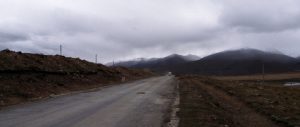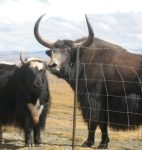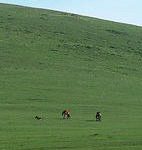In 2003, China introduced a new programme, known as “retire livestock and restore grassland” (tuimu huancao), which called for grazing removal in order to halt and reverse severe grassland degradation. This scheme established various types of fenced zones, including those in which grazing is to be closed for several months annually (a form of rotational grazing), and those where grazing is to be banned for five or 10 years – or in some cases, permanently.
The seasonal rotational grazing and seeding aspects of tuimu huancao resemble other grassland policies, which have been implemented since the 1980s due to concerns about widespread degradation. These have included a number of technical solutions, including the eradication of pikas (a type of rabbit), subsidisation of permanent winter homes, building of fences, provision of livestock shelters and planting of supplemental winter fodder.
In addition to stressing technical interventions, these policies included the extension of the household responsibility system – which gave farmers rights to their fields – from agricultural to pastoral areas. The rationale for promoting the privatisation of use-rights to winter pasture was based on the assumption that this would give herders the proper incentives both to better manage their land and also to become more efficient market producers, thus raising their standard of living. The possibility of having poorer families with fewer livestock rent their pastures to families with more livestock as an income generating strategy for the former is also considered a benefit in some areas.
As is the case with many policies, implementation of tuimu huancao varies widely. In the Tibetan Autonomous Region (TAR), interventions in line with previous policies, such as seeding of grass, are stressed. Herders would prefer to use the fencing material provided by the project to reserve higher productivity alpine marsh meadows for use as winter or emergency fodder. However, officials – who determine which areas will be fenced – follow the policy of fencing off only lower-productivity alpine meadows and sandy areas, for various lengths of time, in order to improve them. This difference, stemming from different understandings of local grassland ecology, leads to a lack of local enthusiasm for the project, as does lack of compensation for loss of grazing areas, particularly where it has been promised to local herders.
Attempts at seeding appear not to be very successful thus far, particularly in the drier western areas of the TAR. In some parts of Sichuan province’s Ganzi prefecture, tuimu huancao has taken the form of distinctive concrete-post fencing along the highway, some of which does not even form full enclosures. However, local residents must guard the valuable fence from thieves, lest the fence goes missing when officials come to inspect.
While some aspects of tuimu huancao extend previous policies by focusing on technical measures to improve herders’ management of their pastures, other components of the programme are quite different from previous policies, insofar as they seek to remove pastoralists from the land entirely. This dramatically different form has been implemented in the core area of the Sanjiangyuan (“the source of the three rivers”) National-level Nature Reserve in Qinghai, a region which has been dubbed China’s “water tower,” and is considered vital to the country’s ecological security. Here, tuimu huancao is being implemented in conjunction with ecological migration, with herders to settle for 10 years, or permanently, in towns.
According to provincial government plans, those who resettle voluntarily in groups and who permanently give up livestock herding are to be given 80,000 yuan (US$11,718) as compensation, as well as 8,000 yuan (US$1,172) of grain subsidies over five years; those who voluntarily resettle as individual households and who give up herding for at least 10 years are given 40,000 yuan (US$5,859) and 6,000 yuan (US$879) as grain subsidies; and finally herders who had moved ahead of project implementation because of deteriorating environmental conditions are to receive 20,000 yuan (US$2,930) compensation packages and 3,000 yuan (US$439) of grain subsidies per year.
Several different goals have been linked to the combination of tuimu huancao and ecological migration: a significant improvement in the region’s ecology, as well as the standard of living of the pastoralists. Furthermore, the State Council’s “White Paper on China’s Policies and Actions for Addressing Climate Change” explicitly lists tuimu huancao as a climate adaptation strategy. To what extent, though, are these goals likely to be met? Evidence to date suggests that the ecological benefits are questionable while the social costs are high.
For tuimu huancao and ecological migration to improve grassland degradation in any given area, several conditions must hold true: grasslands must be degraded; overgrazing must be a primary cause of the problem; and removal of grazing must be able to move the ecosystem out of its undesirable state. However, a number of scientists (for example, see Richard Harris, “Rangeland Degradation on the Qinghai-Tibetan Plateau”, available here) have questioned sweeping statements about pervasive degradation across the plateau. Indeed, some of the data on which commonly cited statistics about the extent of degradation and the rate at which it is increasing is based, appear to be from undocumented and methodologically dubious surveys.
Recent attempts to more rigorously quantify the extent of degradation have had conflicting results. Thus, while overgrazing in the past or present is undoubtedly a key driver of vegetation change in some areas, other factors such as climate change – and interactions between multiple factors – may also play important roles. To date, few rigorous studies have been conducted to investigate these multiple interacting factors, or the extent to which ecosystems can transition to other states under conditions imposed by various interventions. Much work remains to be done in demonstrating the ecological effects of grazing removal in areas where it is being implemented.
Furthermore, there are reasons to believe that tuimu huancao in its various forms will not be a win-win solution for both rangeland health and climate-change adaptation. Large-scale boundary fencing, together with use-rights privatisation, reduces mobility across the landscape. (Although small-scale fencing for reserve pasture or fodder production is generally welcome). This could potentially increase vulnerability to devastating snowstorms, which climate-change models predict will become more frequent and severe. In addition, such fencing can have negative effects for migratory wildlife, as well as for local livelihoods, as a result of the uneven spatial distribution of rangeland resources.
A study conducted by Chinese scientists in Sichuan’s Ruo’ergai county found that the number of herders facing lack of water availability tripled after household rangeland allocation. (See Yan Zhaoli et al, “A review of rangeland privatization and its implications in the Tibetan Plateau”, available here). Furthermore, recent ecological evidence from warming and grazing experiments on the eastern Tibetan plateau suggests that the presence of moderate grazing actually helps control the expected effects of global warming on reduction of biodiversity and rangeland quality. Experimental warming leads to decreased species richness, including of medicinal plants, as well as decreased biomass, including palatable biomass. However, these effects are dampened in the presence of grazing (see articles by Julia Klein, available here). These results suggest tuimu huancao may not be adaptive for climate change.
Studies to date of those who have been resettled through ecological migration also suggest that the benefits of resettlement for improving the livelihoods of herders are overstated. Some who have voluntarily resettled have expressed regrets about doing so, saying they did not realise the extent to which everything in their new town-based lives must be purchased with cash. For many families, government compensation has been inadequate, especially as inflation drives up costs while subsidies remain the same. In one study conducted in Golok, the annual income of those resettled in towns was reportedly lower than their earlier subsistence income, while expenditures were higher; those interviewed also stated that their health conditions had declined after resettlement, because of changes in living conditions as well as diet.
Contributing significantly to the problems is the fact that the Tibetan ex-pastoralists do not have Chinese language and other skills needed to earn an income in the towns. While some are employed as unskilled construction labourers, or have found work in new income opportunities, such as breeding and selling Tibetan mastiffs, most are subsisting only on temporary subsidies and income from digging caterpillar fungus.
Those who do not have the labour power to dig caterpillar fungus are the worst off. Participants of skills training workshops have often still been unable to find work. Once subsidies run out, problems stemming from this unemployment and under-employment will be exacerbated. Indeed, social problems have already emerged, with resettlement areas quickly earning nicknames such as “robber villages,” purportedly because former pastoralists, idle and without income, have resorted to theft.
At the same time, in many parts of the Sanjiangyuan area, it is primarily those families with few or no livestock who have resettled. Some of their pastures are still being grazed by other families, thus undermining the original ecological rationales of the program. Given all of these factors, in many areas, tuimu huancao and ecological migration seem unlikely to be successful in living up to their worthy environmental and social goals. Instead, they may neither improve rangeland conditions nor enhance climate adaptation, while also having negative effects on local livelihoods.
However, much more rigorous empirical work remains to be done to examine the causes and extent of rangeland degradation, the socioeconomic and ecological effects of current policies, and the best measures to enhance local capacity to adapt to global climate change on the Tibetan plateau.
Emily Yeh is assistant professor of geography at the University of Colorado, Boulder. Educated at MIT and the University of California, Berkeley, she has conducted research on property rights, natural resource conflicts, environmental history, emerging environmentalisms and the political economy and cultural politics of development and land-use change in Tibet.
Homepage image by Ba Tu. Sign in Inner Mongolia reads tuimu, or “retire livestock”.



